During the first years of my professional career, I was no copywriter. But I was notorious for writing colossal emails. I only realized this when my boss mockingly referred to one as “another jumbo word sandwich.” Until then, I had always assumed my diligently formulated texts were signaling professionalism. Well, they weren’t. My boss asked me to do something from that moment on: “When you write to me, please, just write like a human. Then things will be fine.”
It’s the best professional writing advice I ever received. And now, I’d like to serve an all-you-can-read menu to help you write for your business (don’t worry, my new boss is paying):

What is professional writing or “business writing”?
For most people, professional writing or business writing means formal, emotionless writing. It’s writing that aims to inform and convince the reader.
That last part is true. The first part is entirely wrong. In fact, it utterly contradicts the second part. Allow me to make a free-spirited leap to hammer down my point:
If “formal” is the opposite of “informal,” then it’s safe enough to assume being formal isn’t the way to inform someone. Makes sense?
Etymologically speaking, this is BS. But it’s impulsive and therefore emotive. And wasn’t it kind of convincing? The point is that emotion plays an important role in decision-making, a.k.a being convinced. So please, before we move on, get rid of the idea that your business writing needs to be dry and flavorless.
That said, here are some other baseline characteristics often attributed to professional writing that I do fully agree with:
- It should focus on your audience and why you’re claiming their time.
- It should be concise. That means: “Short sentences.” There’s little time.
- It should be easy enough to skim through the key points (titles, bullets, white space…). Also, a time thing.
It should not contain any (confusing) errors. Otherwise, you distract the readers. And guess what? They don’t want you to waste their time.
Why is professional writing important for your business?
Writing is one of the most beneficial things you can do for yourself and your business. It helps you see your thoughts in front of your own eyes and therefore clarify your thinking. That means when you write for your business, you’ll understand your business and everything around it better.
Complex thinking sets us apart from animals. But thoughts are elusive. They come and go away. Writing makes things stick.
At Pointerpro: I write about our product, about topics that are important to (potential) users of our product. And by doing so, hopefully, I contribute to making important thoughts stick.
Today, more than ever, effective professional writing means: writing like a human. Why? AI.
How to make your writing more professional: Beware of the human-shaped holes!
Why business writing is mostly digital writing
Millennials and especially Generation Z, are becoming more and more representative in the workforce. They will soon also constitute a big part of the decision-making workforce.
These people have grown up with or were born consuming information digitally. So, there’s no way around it. Your digital presence is crucial. Most of the business writing you’ll do will be published online.
There are countless ways to be digitally present – that require writing:
- Your website homepage and landing pages – where you talk about your services or products
- Blog articles that are used to delve into important ideas, related to your expertise and services
- Emails
- Social media posts
- Online videos, webinars, or podcasts – for which you need scripts
The pitfalls of using Gen AI for business writing
But, I’m assuming, you’re probably not a full-time writer. Very likely, you’re trying to run a business. And so when you do need to do some professional writing, the blank page syndrome lurks around the corner.
Except, there’s ChatGPT now! And it can generate boatloads of writing for you. Enough to keep a search engine up at night.
However, if you publish too much AI content, all too casually, you’ll get in trouble. You’ll have a lot of content, but you will create human-shaped holes in your online strategies. People will disconnect from you.
And people buy from people because the human-to-human connection is what creates trust.

Here are the 3 most common human-shaped holes I identify in AI writing – using an example where I asked ChatGPT to write a landing page introduction about Pointerpro.
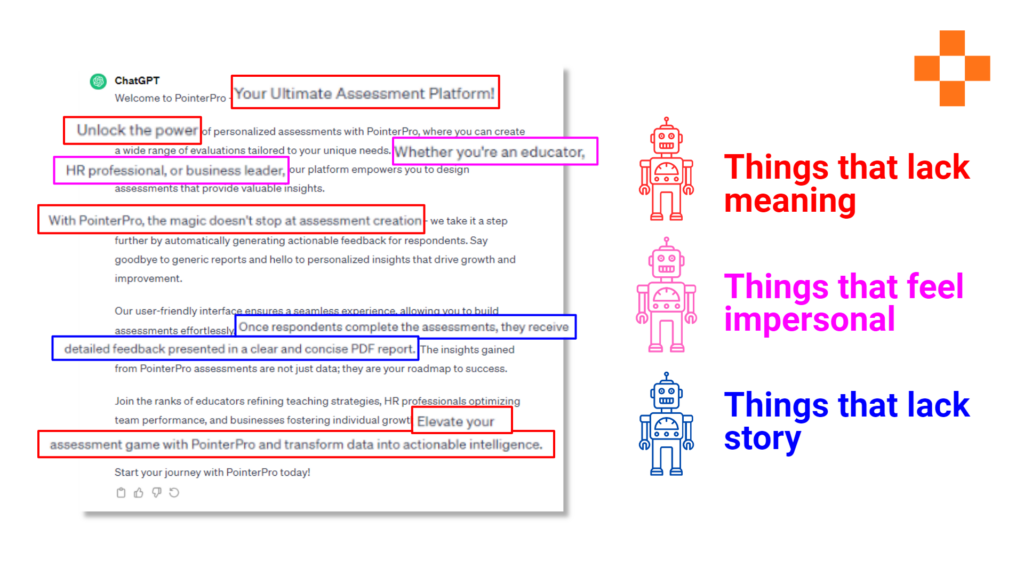
- Things that lack meaning: When there’s as much exaggeration as in the texts marked in red, it’s hard to understand what the writer means. Don’t get me wrong. I love Pointerpro. But what does it mean to be “the ultimate assessment platform” or to “elevate your assessment game with Pointerpro…”? When things are this unspecific, and you can imagine a limitless amount of possible meanings, there is no meaning – only distraction and a waste of the reader’s time.
- Things that feel impersonal: In the first paragraph, the text marked in pink talks about the tool and anyone who could use it. As a reader, you’ll never feel this is meant specifically for you. Of course, it’s ok to point out who your product or service is for, but right out of the gate like this lacks personalization. A lack of personal elements is very common with AI-generated text.
- Things that lack story: There’s a reason journalists ask, “What’s the story?”. Stories are what get human beings to care about information. The sentence marked in blue is correct about our product, but it’s purely factual. It doesn’t allow the reader to imagine a situation where our product would make his life or the life of his customers better.
Bottom line: This is simply not how a human being would communicate to another human being.
How to make your professional writing human again: The ABCs
Now, I don’t suspect you would simply copy-paste this type of AI text. You sense just as much as me that it doesn’t work. But the question is: how do you fill up these human-shaped holes – whether they’re AI-afflicted or not?
The key is not to make things complicated. Simply start by re-injecting the human elements that create connection:
- Meaning
- Personalization
- Storytelling
I’ll review the ABCs for each one. If you want a snackable version of this, you can watch a webinar snippet below in which I go over them, and then skip to some concrete business writing examples.
1. How to write more meaningfully
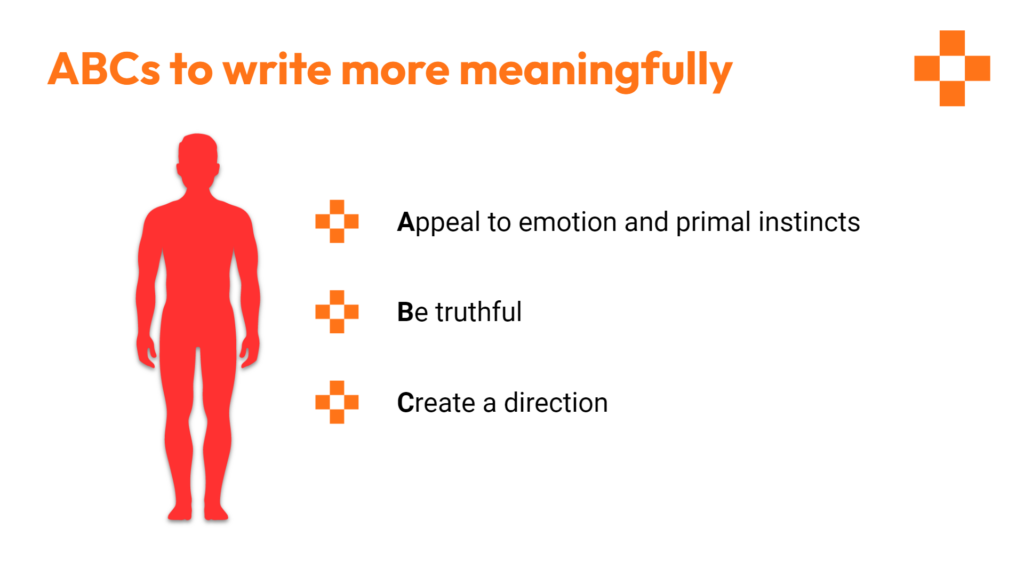
- Appeal to emotion and primal instincts: Emotion is the one thing we’re relatively sure AI can’t generate. So using raw emotion in the right context is a great way of distinguishing your writing from AI-generated writing. Primal instincts are ingrained in our human DNA: Survival instinct, (social) connection, parental instinct, status, safety, identity… If you appeal to these, people will gravitate toward your messaging.
- Be truthful: Use truth as a guiding principle. it makes your messaging over time more consistent. At some point, people want proof of any promise you make, whether you make it explicitly or implicitly. So, don’t use unsubstantiated exaggerations or half-truths in your texts, if you wouldn’t feel comfortable using them in a face-to-face conversation either. One way to be truthful is to be as precise as possible about your service or product’s benefits.
- Create a direction: In French, the word “sense” means “direction” and “meaning” simultaneously. That’s no coincidence. People want to feel that they’re going somewhere. It makes whatever they’re doing meaningful. Generally, the direction people want you to show them is how to get away from the worst possible situation (hell) and closer to the best possible situation (heaven).
2. How to write more personally
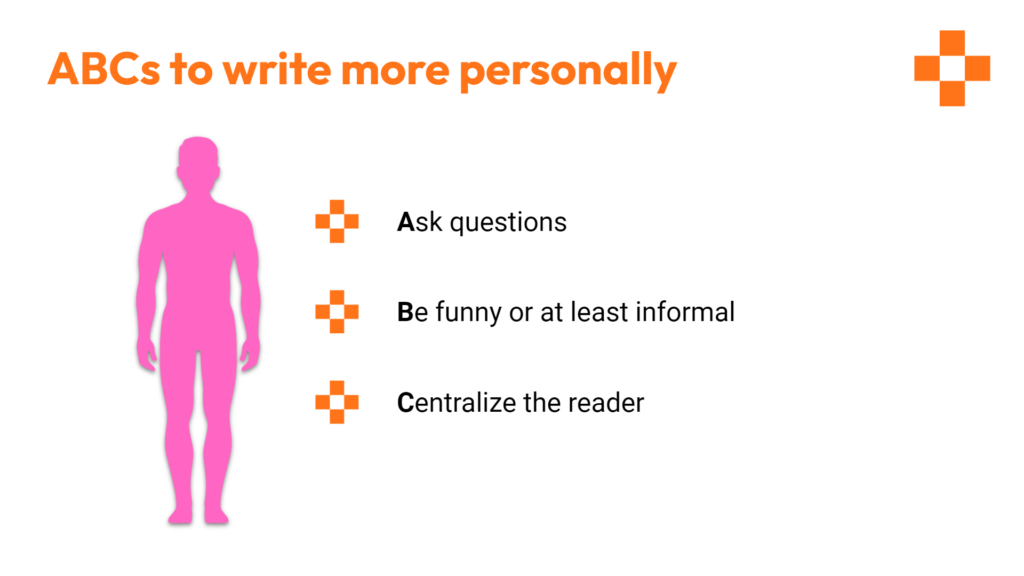
- Ask questions: It will make people feel what they’re reading is about them and that they’re interacting with you – even though they can’t actually answer you. It even feeds their desire to have actual conversations with you.
- Be funny or at least informal: Bear in mind that you’ll often talk about problems your audience is dealing with. That means you’re bringing up factors of stress or tension for them. Relieving that tension through humor or lightness will be appreciated by your reader. Also, if you get people to laugh, it will make you and your message memorable.
- Centralize the reader: This basically comes down to using the words “you” and “your” often, not just when asking questions. It’s all about giving the reader the feeling you’re talking about them. One way to do so is by indirectly encouraging them to give feedback, or showing you care what they think (with a simple “I’d love to know what you think…”). Also important: Steer away from jargon. As a consultant with significant expertise, it’s tempting to demonstrate that expertise. But when you write, speak your audience’s language.
3. How to write with storytelling
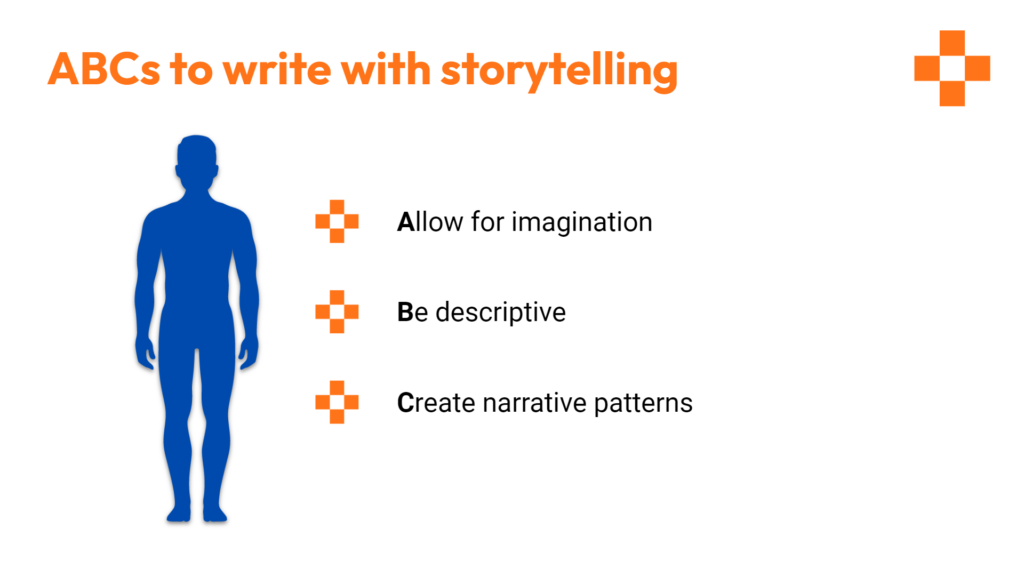
- Create a narrative pattern: When possible, use a beginning, a middle, and an end. Or establish a chronological path – also known as a storyline. When our forefathers had no writing, storylines were the only thing at their disposal to structure and transmit information. That’s where recurring, archetypal storytelling patterns come from.
- Be descriptive: In your storytelling, describe the surroundings and the people. To learn about the world, our forefathers would literally observe what other people did. That’s where the white of the human eye comes from: making it easier to catch someone else’s gaze. So empathizing with other human beings and what happens to them is ingrained in our DNA. It’s also why stories, are the most intuitive way for people to learn and understand concepts.
- Allow for imagination: Let the reader in on the story. That way, your story becomes their story. You may lay out a clear start of a narrative structure and invite the reader to imagine the rest. Your readers will start seeing themselves as the hero of the story you’re telling. That creates a powerful human connection.
Business writing examples
To make this theory of human professional writing more tangible, let’s look at some bad and good business writing practices during a typical customer’s journey. A highly simplified way of representing the journey of your customer – before he or she is converted into a customer – would be this:
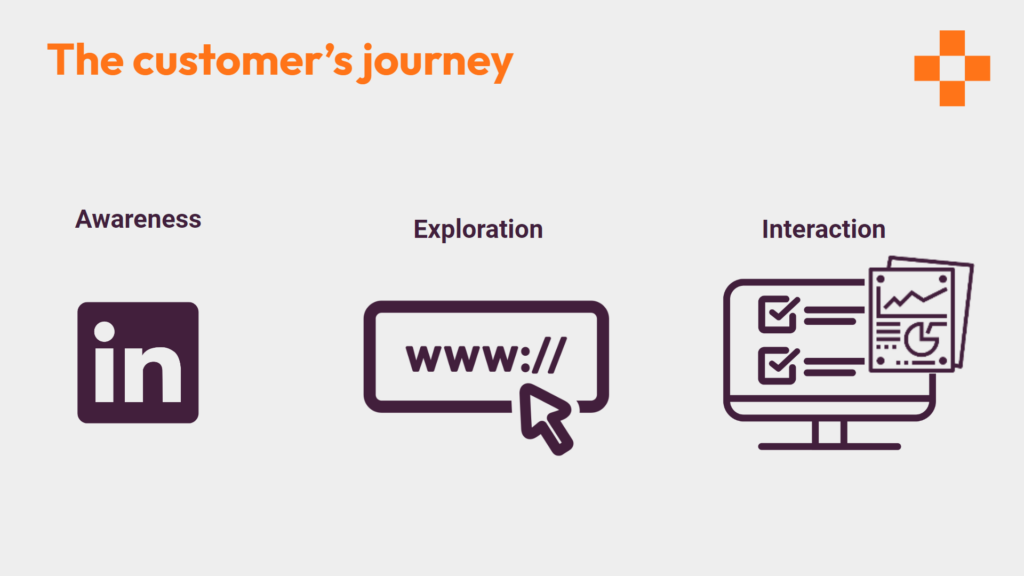
People become aware of your existence because you’re active online – like for instance, on LinkedIn. Then, hopefully, they end up on your website to find out more about you. When they’ve become really intrigued, they start to interact with you.
One way to interact would be by email. However, there are so many important things to be said about business writing for email. Very often, it’s true one-on-one communication. In those cases, I would only assume your writing is already human (and definitely not AI-generated). Here are some great tips about cold email writing, from another article I find very helpful.
So, instead of email, I’ll touch on what Pointerpro clients use to scale up the initial one-to-one interactions with their customers: assessments and personalized reports.
1. Awareness phase: Writing on LinkedIn
Bad professional writing practices
The LinkedIn posts, shown below, are quite long. Who spends this much time writing a LinkedIn post? A robot assistant? But here’s what’s really wrong, or un-human-like, with these texts:
- Meaninglessness: The exaggeration in the titles and subtitles of the posts below gives away that these texts were not conceived by a person, but rather AI-generated. People might still read them, but they’ll feel they’ve read the same thing many times before. They probably have! This creates a disconnect between you and your reader.
- Lack of personalization: Notice how the authors don’t ask any questions to their readers (except for a single one at the very end of the first post). How does it make you feel when someone talks this much to you, without checking in with your thoughts through a question? Disengaged. And rightly so.
- Lack of storytelling: Worse than having no story, is pretending you have a story and not actually having one. The first example talks about “getting started on a journey,” but then it simply lists 3 tools, without illustrating how using them would really affect the reader’s life. The second example allegedly conveys a story about “leaders,” but it doesn’t describe a concrete situation they encounter. It’s just boring.
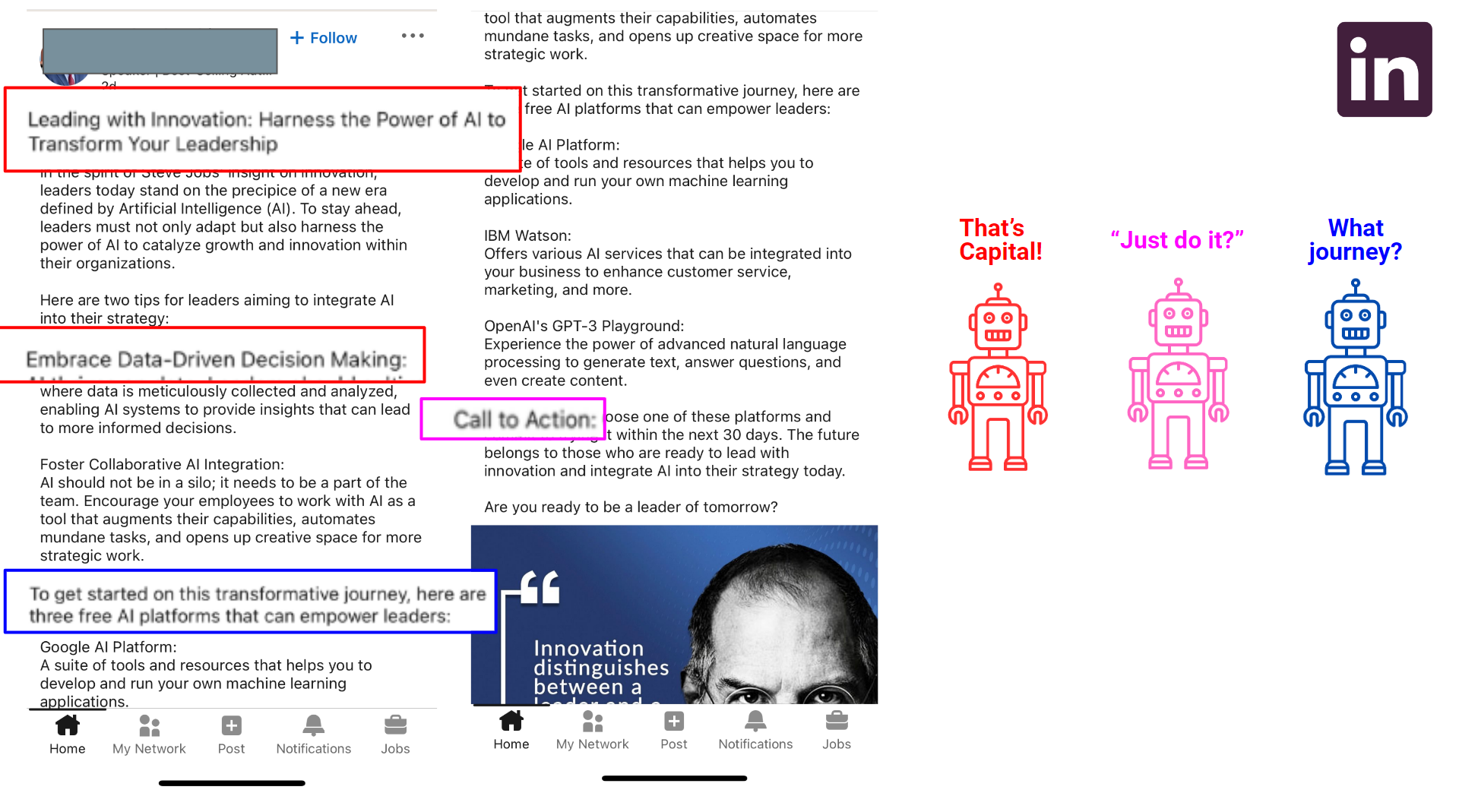
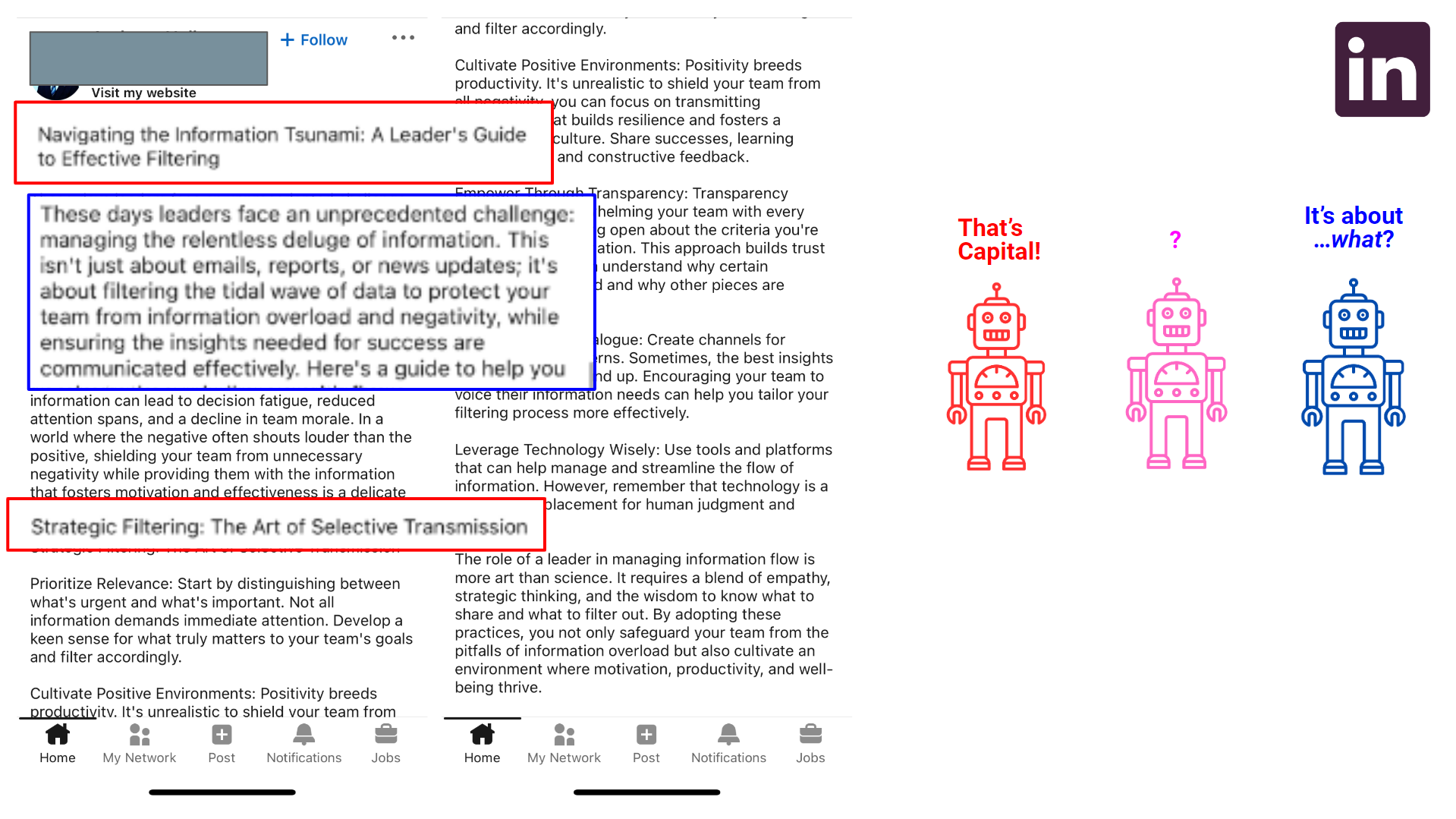
Good professional writing practices
On top of the fact that the good practice example below is much less textual, it has some other strengths:
- Storytelling: Right out of the gate, the post lays out the story of a customer. But the author also lets the reader in on the story, by asking what he or she would do in the same situation.
- Personalization: That same question is of course also a way of making the post feel more personal and conversational. Especially since it comes with a poll. People love to give their opinions.
- Meaning: By stating that a job is, in many cases, your social identity. The post explicitly appeals to identity and status – two primal instincts. It triggers people on a subconscious level to pay more attention.
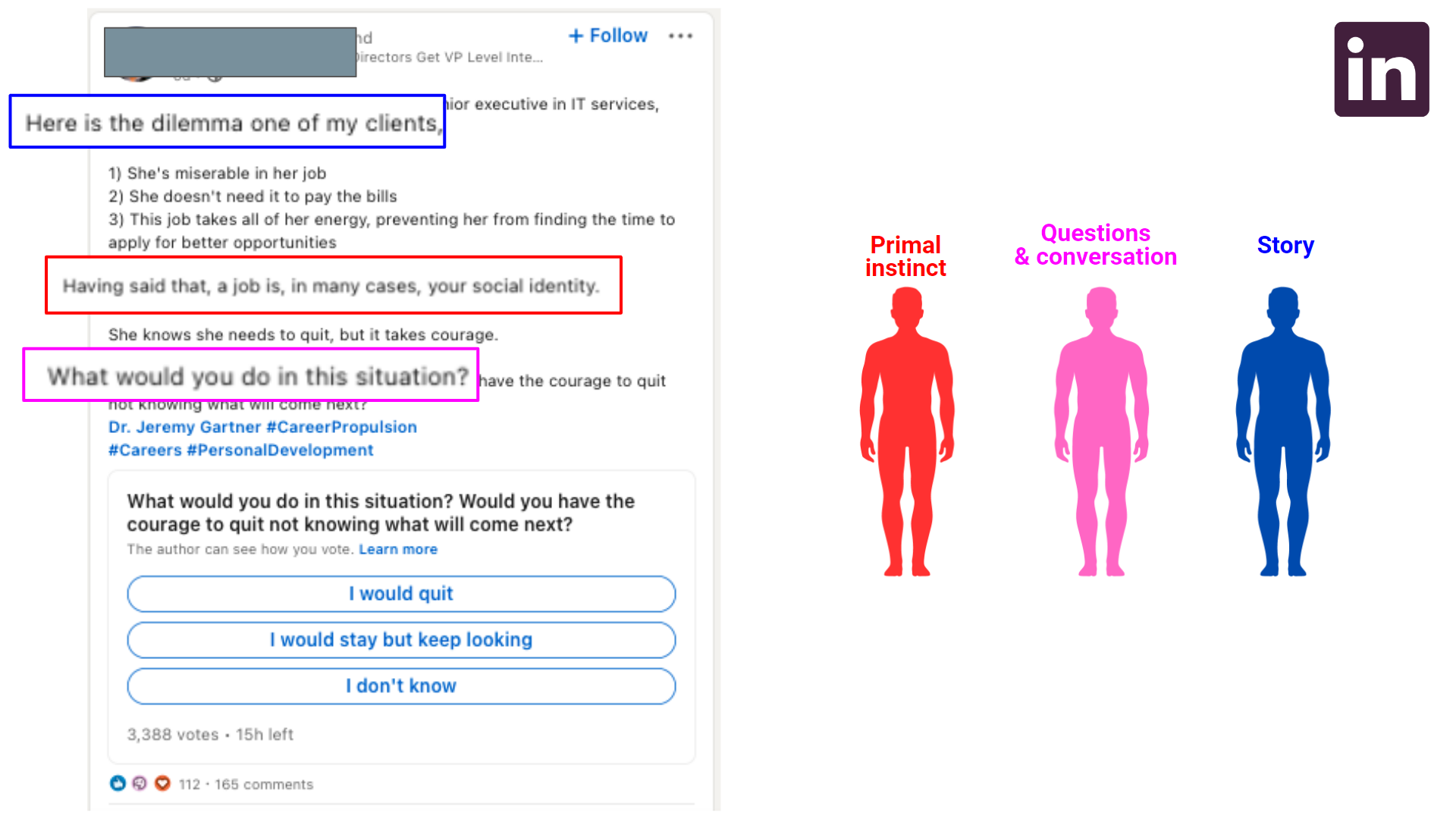
Keep it short and simple. Don’t be fooled. Absolutely nobody reads those long LinkedIn posts you see pass in your feed every so often. Even when these get many thumbs up, it’s mostly fake or brainless engagement. Publish digestible, human-like posts and respond to any reactions to get real conversations going.
2. Exploration phase: Writing content for your website
To cut to the chase, I’ll illustrate both good business writing practices and one bad practice in a single example I found online.
If you’re interested in seeing more examples, check out this video clip from my recent webinar:
Bad, but also good professional writing example
On the website of this strategic leadership coach, I stumbled on an interesting hybrid of non-human and human business writing.
Have a look at the homepage below:
- Lack of meaning: Unfortunately, the main title falls into the trap of using an inflated and, therefore, generic tone of voice. Don’t believe me? Try a Google search query with “unleash your team’s potential” and even add “coaching.” I’m sure you’ll get a sense of how shallow this type of phrase is. I dare you.
- Personalization: The follow-up is much better. The entire first paragraph after the title discusses “you,” the reader. That makes it feel personal.
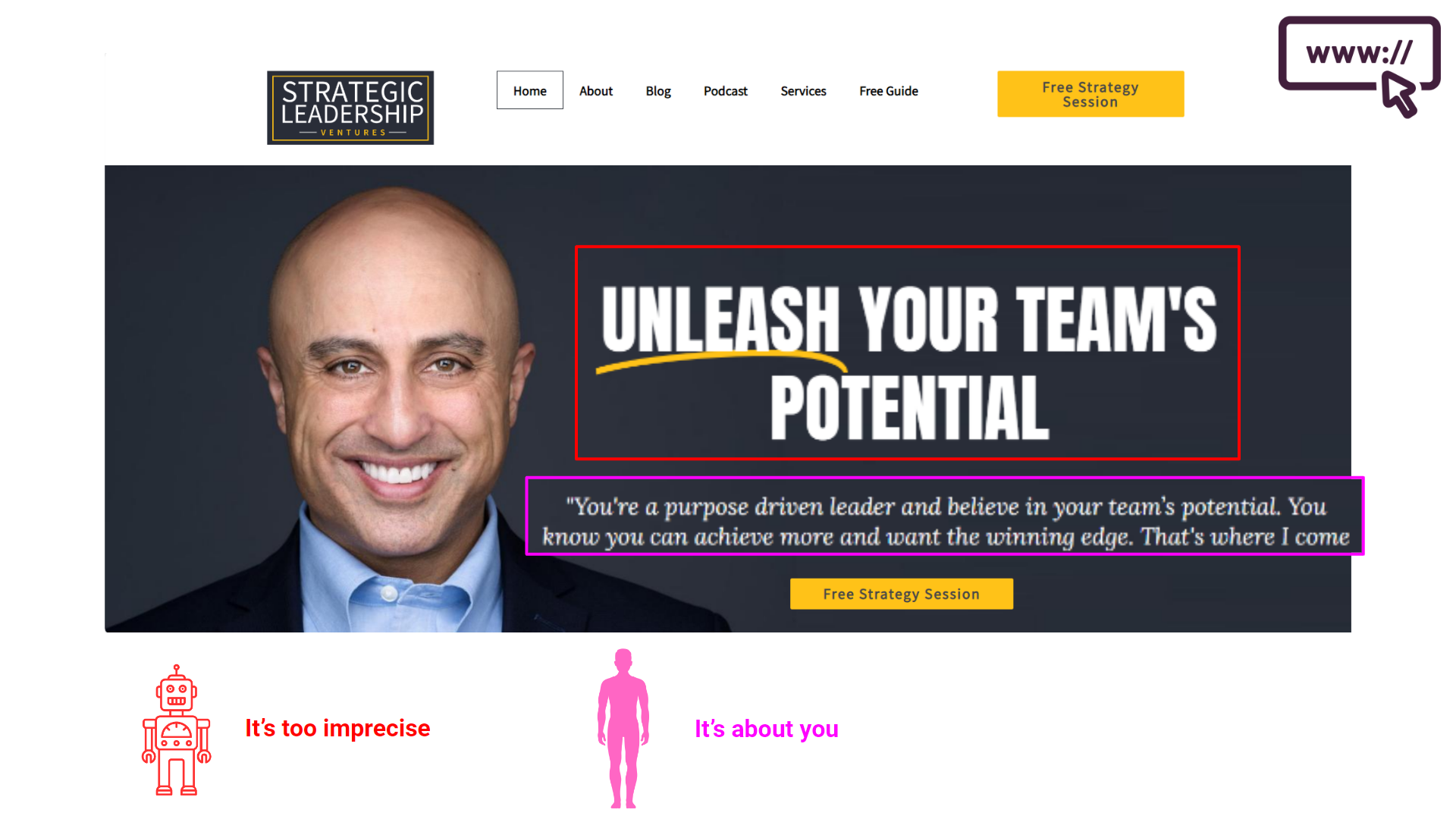
When scrolling down, it gets even better, as you can see below:
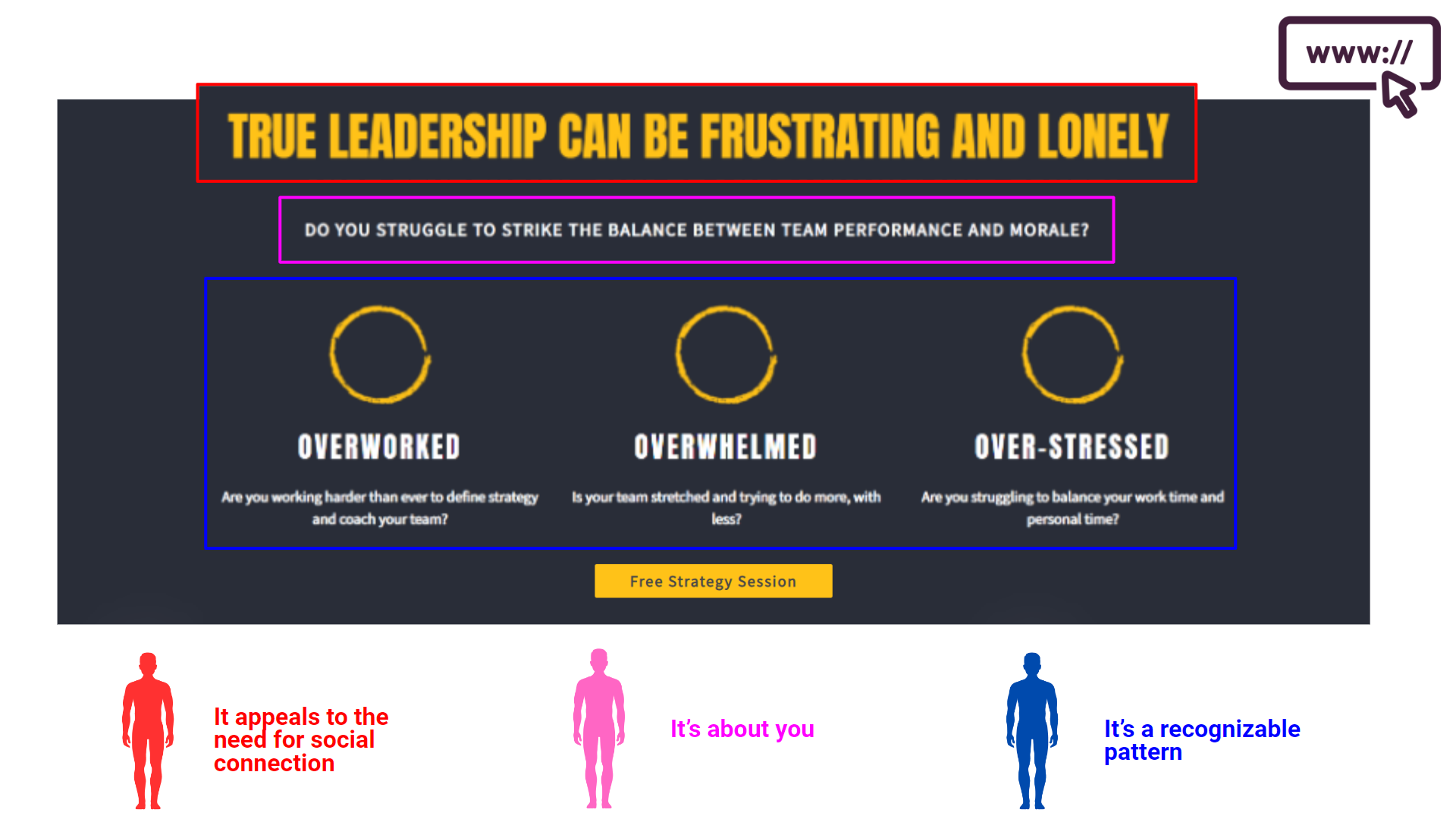
- Meaning: The first sentence uses the concepts of leadership and loneliness (a lack of social connection). These both appeal to primal instincts.
- Personalization: Again, in the follow up the website page talks “you” by asking you a question.
- Storytelling: The last bit is what impresses me most, as I identify some really concise storytelling. The three circles lay out a chronological structure: It tells a story about you from being overworked, to feeling overwhelmed, to feeling over-stressed during your personal time.
Overall this website homepage is very concise. The author doesn’t bother you with much text. And the little text he uses is focused entirely on you, the potential customer – not himself, the service provider.
3. Interaction phase: assessments with personalized reports
As a final example, let’s have a look at another consultancy/coaching service provider. This one is actually a Pointerpro client. It’s a business built around a method to help entrepreneurs, teams, and organizations perform with more confidence and clarity.
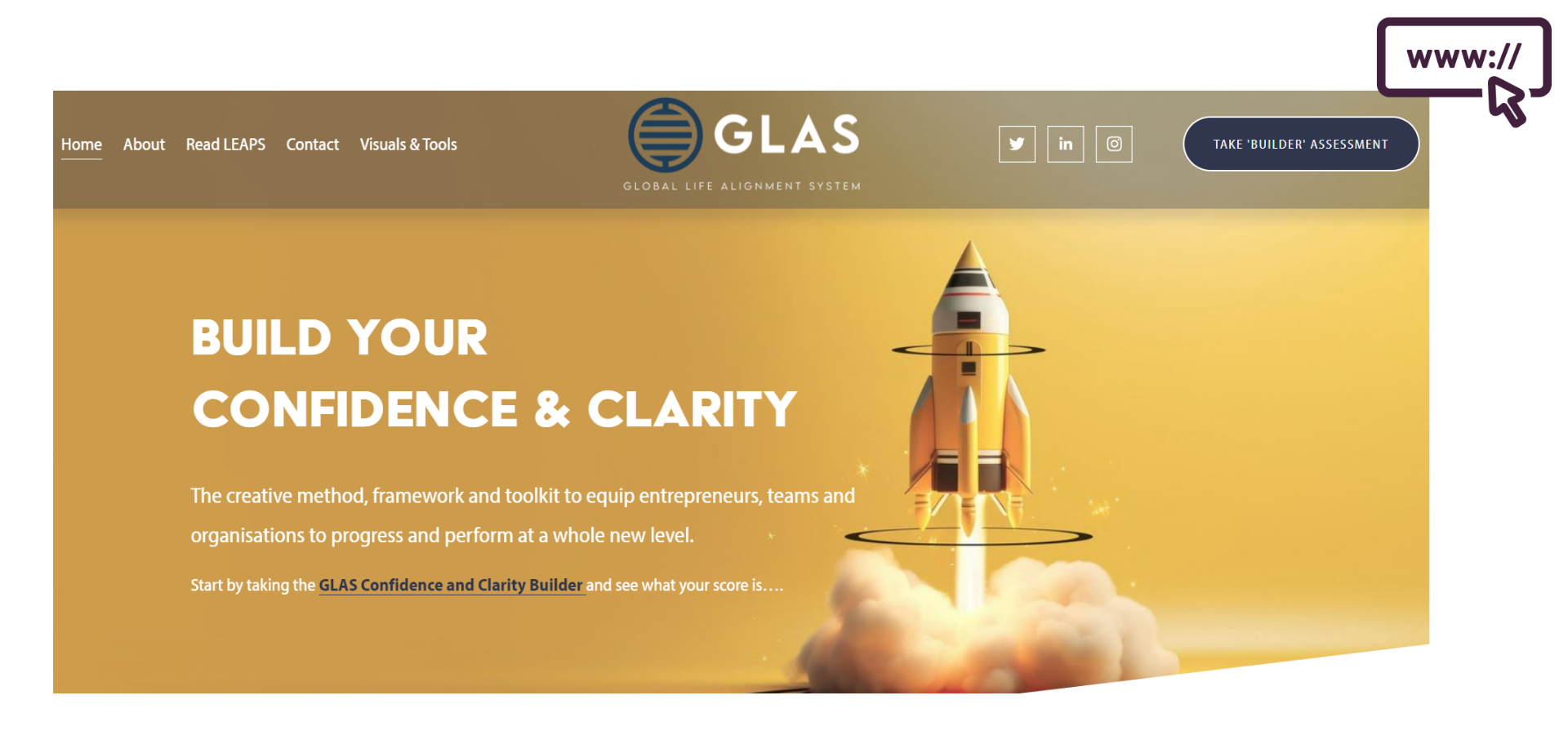
Similarly to the previous example, the website has the virtue of not overloading you with text. The main title is a clear call to action and as a reader, you’re immediately invited to take the “GLAS Confidence and Clarity Builder” assessment.
You instantly get the feeling that it’s all about you. The online assessment and report that follow, confirm that feeling.
One way is by asking you for your first name which is re-used to make the personalized report more conversational. But moreover, the assessment doesn’t ask for your email address or company name until the very end. So, even though the assessment is also a commercial tool to attract new customers, it doesn’t come across that way at all.
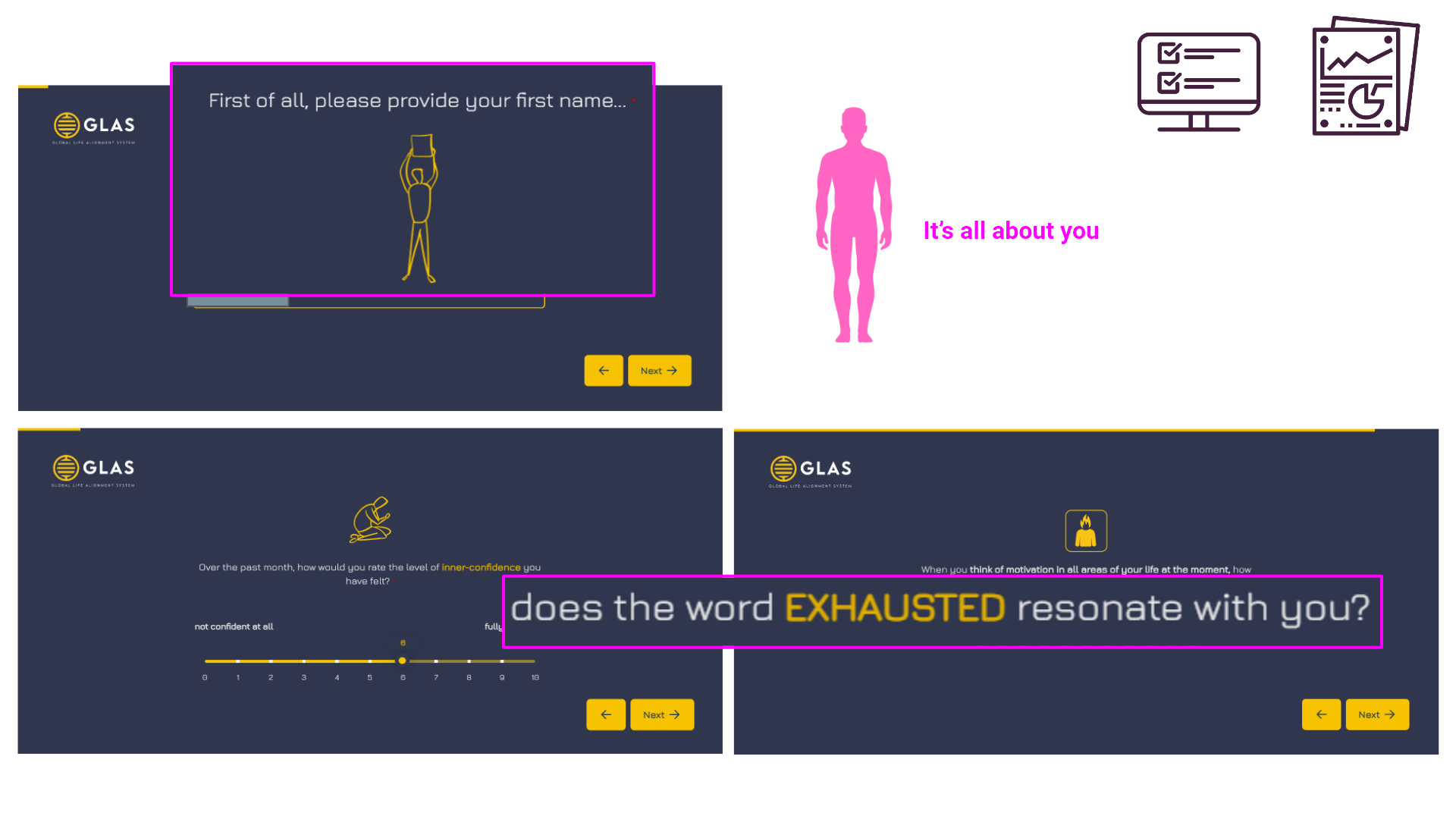
That’s of course also because the PDF report that follows is ultra-valuable with more than 20 pages of highly personalized and well-presented insights.
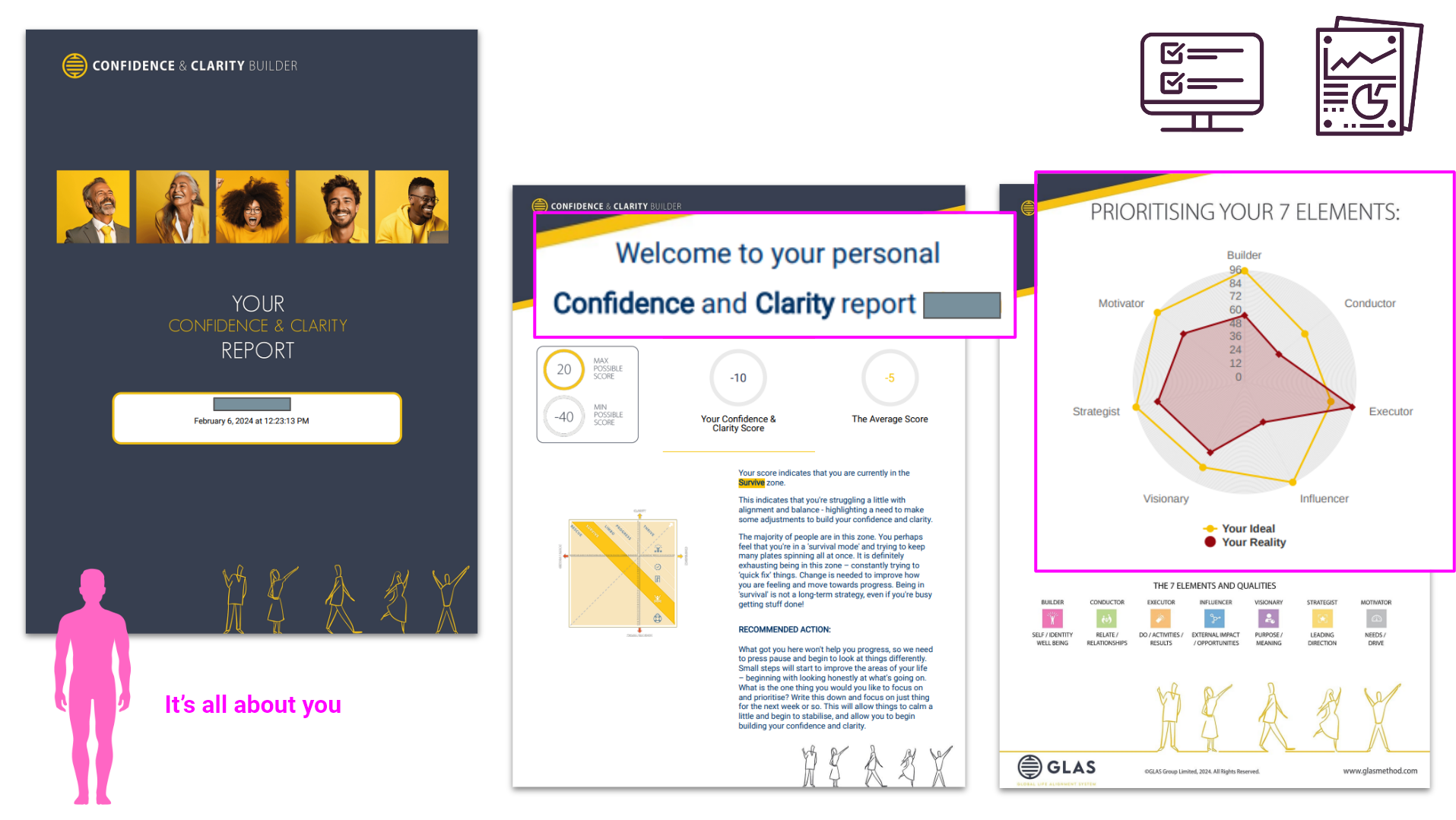
Business writing and professional writing: Key tips to move on from here
So before I close, to be clear: the message of this article is not to stop using AI to create any of your content. Very often, you just need to get started. And ChatGPT or other AI tools can be super helpful for that.
A common saying among copywriters is that “writing is rewriting.” So you might as well rewrite a draft delivered by AI. That said, please take into account the three following tips:
Tip 1: Define and hold on to your key messages
If you plan on writing a lot of content and publishing it: website pages, blog articles, social media posts, online advertising…
…and if you don’t have a real content plan, then give yourself at least some sort of bearing by doing the following:
- Define key activating messages that you can honestly tie your product or service into.
- For everything you ever publish, double-check if you can categorize it under one of these key messages
At pointerpro we have about 9 key messages. They’re actually implied promises that we know our software delivers on.
The very key message behind this blog article is “humanize your digital service.” As you’ve seen in the assessment/personalized report example from our client, our assessment platform helps her to personalize her online assessments and therefore make them feel more human.

If you plan on writing a lot of content and publishing it: website pages, blog articles, social media posts, online advertising…
…and if you don’t have a real content plan, then give yourself at least some sort of bearing by doing the following:
- Define key activating messages that you can honestly tie your product or service into.
- For everything you ever publish, double-check if you can categorize it under one of these key messages
At pointerpro we have about 9 key messages. They’re actually implied promises that we know our software delivers on.
The very key message behind this blog article is “humanize your digital service.” As you’ve seen in the assessment/personalized report example from our client, our assessment platform helps her to personalize her online assessments and therefore make them feel more human.
Tip 2: Use your own knowledge as digital content
The way two human beings connect in real life is by talking about what’s actually on your mind and in your head. Otherwise, you don’t connect.
If you want to connect with your audience online, especially if your in a people-based service business – it’s the same.
AI only delivers boatloads of collective knowledge – and it tends to ramble on. So, to stand out, use your specialized knowledge and personal experience as a starting point and leverage it with AI or other tools, like Pointerpro.
Tip 3: Always fill up the human-shaped holes in your professional writing
If you like what you’ve read in this article, learn the ABCs I discussed by heart. Look for human-shaped holes in your writing and ill them up.
Click here, if you’d like to download a printout.


